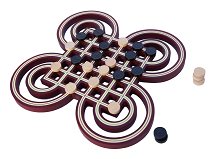Rules of Ancient Egyptian Senet or Senat
Senet (or Senat or Sen't) was a game played by the ancient Egyptians and is an ancestor of Backgammon. It is not known how the game was played exactly but the rules can be deduced to a certain extent and the following is a popular conjecture.
See also: Ancient Egyptian Senet.
Equipment
A Senet board consisted of three rows of ten squares set in a rectangle. In one corner, the square that is assumed to be the final square has a single stroke, the next one along in the row, two strokes, the next one three strokes, the next a diagonal cross and the fifth one along a symbol with a circle and cross. It is assumed that these were squares 26 to 30 of a 30 square track that started in the opposite corner, went along one row, travelled back down the middle row and finished along the row ending in these special squares. Square 15 also often contained a symbol and was called the House of Rebirth. Square 26 with a cross and circle symbol is known as the House of Happiness. Square 27 with the cross is known as the House of water. Each person has five pieces of contrasting hue or contrasting pattern. The movements of the pieces are determined by the throw of four split twigs with a dark face on one side and a light face on the other (binary lots).
Preparation
Pieces are placed on the first ten squares of the first row with the colours alternating.
The Play
Players take turns to move a single piece per throw of the split twigs viz:
- 0 light faces up - 5 and an extra throw
- 1 light face up - 1 and an extra throw
- 2 light faces up 2
- 3 light faces up 3
- 4 light faces up 4 and an extra throw
These rules are provided by Masters Traditional Games, an Internet shop selling quality traditional games, pub games and unusual games. For general information or for copying and copyright, see our Rules Information page.
Our rules are comprehensive instructions for friendly play. If in doubt, always abide by locally-played or house rules.
Copyright James Masters, 2025. All rights reserved.


























